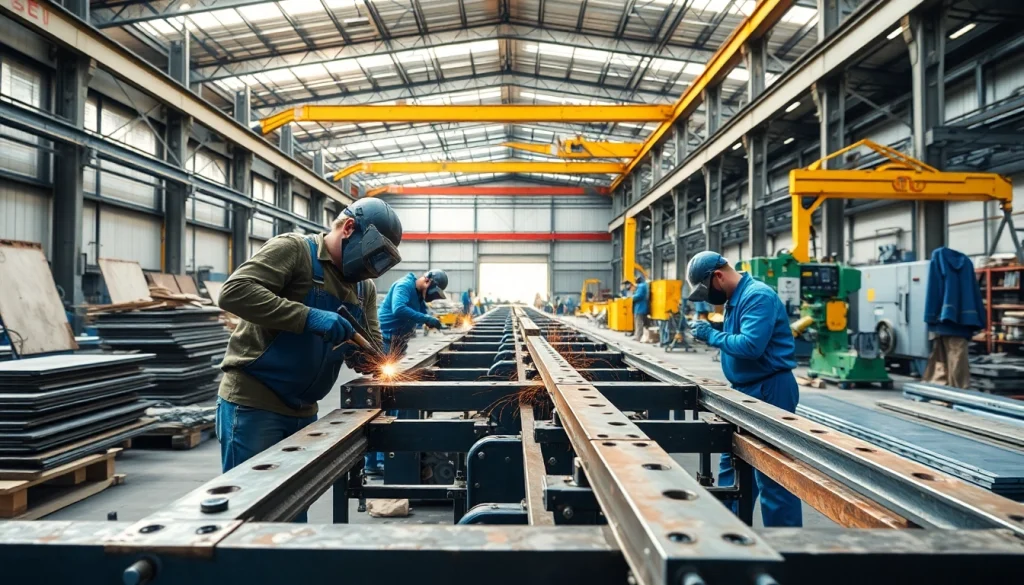Understanding Custom Steel Fabrication
What is Custom Steel Fabrication?
Custom steel fabrication is the process of creating specialized steel products that meet specific requirements tailored to unique applications. Unlike mass production methods, custom fabrication is characterized by its attention to detail and the ability to produce components in various shapes and sizes, ensuring they fit perfectly with their intended use. Through this method, fabricators can leverage different techniques—such as welding, cutting, bending, and assembling—utilizing steel in versatile applications, from building construction to automotive manufacture.
The significance of custom steel fabrication lies in its ability to meet the needs of various industries, providing solutions that standard products cannot fulfill. Each project often involves input from engineers, designers, and fabricators working together to ensure optimal functionality and aesthetic appeal.
Importance of Custom Steel Fabrication in Various Industries
The role of custom steel fabrication is critical across multiple sectors, including construction, manufacturing, and infrastructure development. In construction, for example, structural steel is fabricated to create frameworks that ensure stability and strength in buildings and bridges. The automotive industry relies heavily on this fabrication practice for producing components that must meet precise specifications for safety and performance.
Additionally, industries such as aerospace, defense, and energy greatly benefit from custom fabrications, where specialized parts are crucial. The custom nature of these components often leads to improved efficiency, durability, and performance, while also allowing for innovations in design and function that set modern industries apart.
Key Processes Involved in Custom Steel Fabrication
Custom steel fabrication encompasses several key processes that work in tandem to produce high-quality, tailored components. Here’s a breakdown of the primary methods involved:
- Cutting: This involves the removal of material from sheets or plates to create specific shapes. Techniques such as laser cutting, plasma cutting, and water jet cutting are commonly used for their precision.
- Bending: Bending processes, including press braking and roll bending, are utilized to shape metal into desired angles or curves, essential for creating frames or structural supports.
- Welding: One of the most critical processes, welding joins metal pieces together to form a single structure. Various techniques such as MIG, TIG, and arc welding are employed based on the materials and strength required.
- Finishing: After fabrication, surface finishing processes like grinding, painting, or galvanizing are often added to enhance the aesthetic while providing protection against corrosion.
Essential Tools for Custom Steel Fabrication
Overview of Tools Used in Custom Steel Fabrication
The tools used in custom steel fabrication are essential for ensuring precision, efficiency, and safety during the fabrication process. Key tools include:
- Band Saws: Ideal for cutting steel into various shapes, band saws are versatile and allow for intricate cuts.
- Laser Cutters: These provide highly accurate cutting and engraving options, making them perfect for custom designs.
- Welding Machines: Essential for fusing metal components, the type of welder used will depend on the welding technique being applied.
- Press Brakes: Used for bending and shaping metal sheets into various angles, essential for creating frames and supports.
- Drill Presses: For drilling precise holes in steel; invaluable in preparation for bolting or fastening components together.
Advancements in Technology for Steel Fabrication
Recent technological advancements significantly influence the steel fabrication industry, leading to improvements in efficiency, speed, and quality. Automation and robotics are becoming increasingly prevalent in production lines, enhancing productivity while minimizing errors. CNC (Computer Numeric Control) machines are utilized to automate cutting and shaping processes, allowing for intricate designs and complex cuts that would be difficult or time-consuming to produce manually.
Additive manufacturing, commonly known as 3D printing, is also making inroads into the metal fabrication sector, enabling the creation of parts that are lighter, stronger, and tailored for specific functions. Moreover, new materials and techniques are emerging, pushing the boundaries of what can be achieved in custom steel fabrication.
Choosing the Right Equipment for Your Projects
Selecting the proper equipment for custom steel fabrication is pivotal to the success of any project. Factors to consider include:
- Project Requirements: Analyze the specific needs of the project, including the types of materials to be used and the desired end product.
- Scalability: Ensure that the equipment chosen can accommodate current and future project sizes, providing flexibility as needs grow.
- Budget: High-quality equipment can be a significant investment. Balanced decision-making based on budget constraints without compromising essential functions is critical.
- Operator Skill Level: Ensure that operators are adequately trained to use advanced equipment. Investing in training can be as critical as purchasing the equipment itself.
Best Practices in Custom Steel Fabrication
Effective Planning for Custom Steel Fabrication Projects
Planning is the backbone of any successful custom steel fabrication project. Effective planning incorporates the following strategies:
- Define Project Goals: Clearly outline project objectives and design specifications before beginning the fabricating process.
- Timeline Development: Create a realistic timeline that reflects all stages of the project, allowing room for unexpected delays and ensuring timely delivery.
- Material Selection: Choose materials wisely based on strength, weight, and cost considerations that suit the intended use and environment.
- Collaboration: Maintain constant communication between designers, engineers, and fabricators to ensure alignment and address any issues that arise during fabrication.
Quality Control Measures in Custom Steel Fabrication
Quality control is crucial in the custom steel fabrication process, safeguarding the integrity and functionality of the finished products. Implementing robust quality control measures involves:
- Material Inspection: Inspect incoming materials for defects before they enter the fabrication process.
- In-process Checks: Regular inspections during fabrication ensure that processes conform to predefined specifications and tolerances.
- Final Testing: Conduct tests on finished products, such as stress tests or visual inspections, to verify that they meet safety and quality standards.
- Documentation: Track and document all inspections, tests, and audits to enforce accountability and facilitate continuous improvement.
Safety Protocols in the Fabrication Environment
Ensuring safety in the steel fabrication environment is not just a regulatory requirement; it is essential for the well-being of workers and the longevity of the projects. Key safety protocols include:
- Personal Protective Equipment (PPE): Ensure that all personnel are equipped with the necessary PPE, including gloves, helmets, and eye protection.
- Training Programs: Regularly conduct safety training sessions to keep employees updated on best practices and new safety regulations.
- Equipment Maintenance: Carry out regular checks and maintenance on machinery to prevent malfunctions and accidents.
- Emergency Procedures: Establish clear procedures for emergencies, including fire drills and first aid training.
Common Challenges in Custom Steel Fabrication
Identifying and Overcoming Fabrication Issues
Throughout the custom steel fabrication process, several challenges may arise, including material defects, design flaws, or discrepancies between design and end product. It is essential to identify these issues early to mitigate their impacts:
- Prompt Communication: Establish communication protocols among team members to address concerns quickly.
- Regular Design Reviews: Involve multidisciplinary teams in reviewing designs to prevent errors before they reach the fabrication stage.
- Use of Technology: Implementing software for design simulations can help visualize and address potential challenges.
Managing Costs in Custom Steel Fabrication
While custom steel fabrication often comes with a higher price tag than standard manufacturing processes, there are strategies to manage and reduce costs effectively:
- Optimize Material Use: Conduct thorough planning to minimize waste and optimize the use of raw materials.
- Negotiate with Suppliers: Build strong relationships with suppliers to secure favorable pricing on materials.
- Invest in Technology: Gradually adopt advanced technologies that increase efficiency and reduce labor costs over time.
Keeping Up with Industry Trends and Innovations
The custom steel fabrication industry is continually evolving, with new trends and innovations shaping its future. Staying updated with these changes is essential for competitiveness:
- Industry Networking: Participate in trade shows and networking events to learn about the latest technologies and advancements.
- Continuous Education: Encourage staff to pursue continuous education on trends such as automation and sustainable materials.
- Subscriptions to Industry Publications: Regularly read industry-related magazines and reports to stay informed about market trends and technological developments.
Future of Custom Steel Fabrication
Emerging Trends in Custom Steel Fabrication
Emerging trends in custom steel fabrication suggest a shift towards greater efficiency and sustainability, emphasizing the industry’s adaptation to new technologies. Additive manufacturing, mixed with traditional fabrication methods, presents innovative ways to produce components, further pushing the efficiency envelope. Additionally, the integration of AI and IoT within fabrication processes allows for real-time monitoring and adjustments, ensuring optimal production and minimizing waste.
Sustainability in the Steel Fabrication Industry
Sustainability has become a core focus within the steel fabrication industry. More businesses are adopting eco-friendly practices, including utilizing recycled materials and implementing energy-efficient processes to reduce their carbon footprint. Efficient waste management strategies are also pivotal, recycling scrap steel and using alternative energy sources to power operations contribute positively toward sustainability goals.
Predictions for Future Developments in Custom Steel Fabrication
Experts predict significant advancements in robotics and automation will continue to shape the future of custom steel fabrication. Predictive maintenance powered by AI will allow for more proactive operations, reducing downtime and enhancing productivity. Furthermore, with advancements in materials technology, engineers will achieve lighter, stronger, and more versatile designs, leading to the creation of innovative products and structures that were once deemed impossible. This move toward technological integration will undoubtedly redefine how custom steel fabrication operates, improving quality and efficiency in the years to come.


